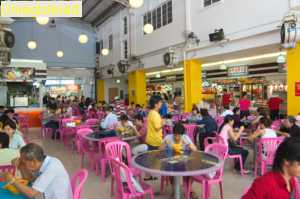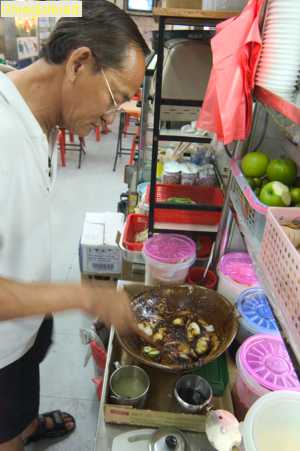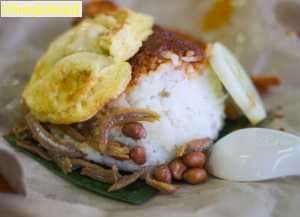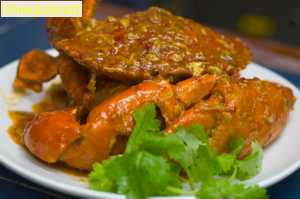Story and Photos by Austin Bush

Malay

Chinese
On their own, Chinese dishes are probably the least spicy in Singapore. The Chinese in Singapore love noodles and fortunately for lovers of spicy food, a hot condiment is almost always provided, whether it’s sliced chiles in vinegar, or bright red chile paste. However, one Chinese surprise comes in the form of a curry, and is a competitor for one of the hottest curries in all of Singapore. In a country mad about curries, Nana Curry is a Chinese-run establishment that has become a Singapore favorite. The curries at Nana, which come with either fish, chicken or mutton, are at the same time subtler and simpler, but also much spicier than their Indian cousins. The mutton curry in particular is more similar to a spicy stew than a curry. Containing hearty chunks of potatoes and falling-off-the-bone stewed mutton, it is pleasantly, but not overwhelmingly spicy. Unlike Indian or Malay curries that are typically served with rice, you can choose to cool your palate with slices of delicious grilled garlic bread. Nana Curry is available at the Amara Food Court (Tanjong Pagar MRT).
Indian
The vast majority of Indian food in Singapore is southern Indian in origin. Tamil-owned “banana leaf” restaurants abound, where a vegetarian meals of rice and spicy accompaniments are served on a banana leaf and eaten using the fingers. Amid this jungle of banana leaves can be found a Singapore favorite: fried noodles, or mee goreng. Malay in name (“goreng” is Malaysian for fried), and Chinese in form, mee goreng is today almost exclusively prepared by Muslims of Indian origin. In this dish, yellow Chinese noodles (“mee”) are fried with tomatoes, vegetables and a piquant sambal chile paste, then topped with a fried egg. The dish is garnished with sliced cucumbers and topped with a sweet chile sauce. Try any of the small cafes and restaurants in Little India (Little India MRT).
Thai

Singaporean
Singaporean food can be seen as a blend of all the aforementioned cuisines, but it more commonly takes the form of a classic dish, be it Chinese or Indian, that has been adapted by the different groups preparing it, making it uniquely Singaporean. A perfect example of this is rojak, a dish of Indonesian origin, made here with classic Chinese ingredients and prepared by just about everybody. Rojak is essentially a savory “salad” of crispy fruits, such as green apples, pineapple and cucumber, combined with tofu and fried dough sticks, then tossed with a thick, dark dressing of palm sugar, tamarind juice, shrimp paste and chiles. The whole sticky mess is then served sprinkled with ground peanuts. Rojak is made to order, and as a result, is potentially one of the spiciest in Singapore. The most famous rojak in Singapore is Lau Hong Ser Rojak, located in the Dunman Food Centre.

Eurasian
Singapore, along with Malacca and Penang, was part of the English possessions known as the Straits Settlements. These ports were cultural melting pots of European and Asian cultures, and Malacca in particular, is the origin of an entire repertoire of English and Portuguese-influenced dishes. The most well-known of these is the aptly-named devil curry, a fiery red mixture of leftover meats, chiles and potatoes. Devil curry can be found at Village Gossips Cafe (Block 4, Changi Village, near Subway), where you can order the dish with the degree of spiciness you desire.
Recipes

For the coconut rice:
Bring the salted water to a boil in a large saucepan. Add the rice and pandan leaf, reduce heat to a simmer and cook until the liquid is absorbed.
Stir in the coconut cream, cover and allow the ice to absorb its fragrance. Use a fork to fluff up the rice grains before serving.
Ikan bilis are fried, dried anchovies. Serve this sambal as a garnish for simple fried fish or omelet and sliced fresh cucumber over rice. Look for dried anchovies and shrimp paste in Asian grocery stores. Tamarind paste is often used in East Indian cooking; look for it in Asian or Indian markets.
Heat 1/4 cup of oil in a wok and fry the dried anchovies over medium heat until they are crisp. Remove the fish from the pan and drain on kitchen towels. Wipe the wok clean.
In a food processor or blender, process the softened chiles, garlic, shallots and shrimp paste to make a thick paste.
Heat another 1 tablespoon oil in the wok. Fry the paste till brown and fragrant, then add sugar and tamarind water. Fry for another minute or so.
Store sambal in a resealable container in the refrigerator.
All noodle dishes are essentially Chinese in origin, but the addition of dried spices, including a generous amount of chile, makes this dish unmistakably Singaporean. Hokkien noodles look like thick, yellow spaghetti. Look for them in the refrigerator section of your Asian grocery store. If you can’t find them, you can substitute any other fresh wheat and egg noodle. You can also substitute bok choy or broccoli florets for the Chinese flowering cabbage.
For garnish:
Heat the oil in a wok set over low heat. Saute the onions till soft. Add the chile paste and curry powder, stirring constantly. Sprinkle a little water into the pan to prevent the paste from burning.
Turn the heat to medium. Add the potatoes, then the greens, tomato and bean sprouts. Season with salt.
Loosen the noodles and add them to the wok. Add the soy sauce and tomato sauce. Mix thoroughly. Sprinkle a little water, if needed, for easier mixing. Garnish and serve immediately.
When making this classic Thai dish feel free to add more lime juice, fish sauce, or chiles to suit your taste. Look for straw mushrooms dried or canned; substitute white button mushrooms. If you can find fresh lemongrass in your Asian market, look for it dried. Tom yam paste is essential to this dish; if your market doesn’t carry it, pick another recipe.
Blanch the bean sprouts and water spinach in a pot of boiling water; or microwave them on high for 2 minutes.
Place yu tiao and taupok in an oven on low for 10 minutes to make them crispy. Cut into small pieces.
Toss the vegetables with dressing, top with the crisp yu tiao and taupok and serve.
For the dressing:

Singapore’s unofficial national dish, Chile Crab is best consumed with a crusty baguette or mantou, steamed Chinese buns, to soak up the piquant sauce.
Subdue the crabs by storing them for an hour or so in the freezer.
Bring to a boil a pot of water large enough to submerge crabs. Boil the crabs for about 5 minutes or until they turn pink. Remove with tongs and plunge into cold water to stop the cooking process.
Cut away the strings or rubber bands from the claws and pull off the shells by prying under the underbelly flaps. Remove the head sacs, found within the shells, and the spongy gills. Using a knife, detach claws and cut the bodies into 4 or more parts. Use a pestle to crack claws. Leave aside.
Make the sauce. Put the onions, ginger, garlic and chile in a food processor and pulse until it comes into a thick paste.
Heat the oil in a wok. When it’s hot, sauté mixture till fragrant, then add tomatoes. Cook until the mixture is caramelized, then add the taucheow and sugar. Stir well and allow to simmer, adding a little water if it seems too thick, till the flavors come together.
Add the crab pieces to the wok and toss to coat. Taste, and season with a drizzle of light soy sauce, if needed. Top with chopped Chinese celery and serve immediately with crusty bread on the side.
Devil Curry is a Eurasian dish that traditionally uses meats leftover from large meals such as Christmas dinner, and brings them together with a spicy mustard and chile laced gravy.
Heat the oil in a pot large enough for the stew ingredients. Fry the ginger strips until browned, then remove them from the pot.
Fry the mustard seeds until they pop. Add the onion and garlic, followed by the chile paste and tomatoes, then the shrimp paste and powdered spices.
When the spices are fragrant, brown the chicken pieces. Add water to just cover the meat, season with salt and sugar and bring to a boil. Cook for 10 minutes.
Add the potatoes and sausages and turn down fire to simmer until chicken is tender. Finally add the cucumber, green chiles and roast pork, if using. Leave for a while for flavors to mature and squeeze in lemon juice just before serving.





